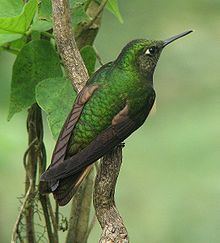
The rufous-breasted hermit or hairy hermit is a hummingbird that breeds from Panama south to Bolivia, and on Trinidad, Tobago and Grenada. It is a widespread and generally common species, though local populations may change in numbers and disappear altogether in marginal habitat.

The hermits are tropical and subtropical hummingbirds in the subfamily Phaethornithinae, comprising 37 species in six genera. They occur from southern Mexico, through Central America, to South America as far south as northern Argentina.

Phaethornis is a genus of hummingbirds in the hermit subfamily, Phaethornithinae. They occur from southern Mexico, through Central America, to South America as far south as northern Argentina.

Amazilia is a hummingbird genus in the subfamily Trochilinae. It is found in tropical Central and South America.
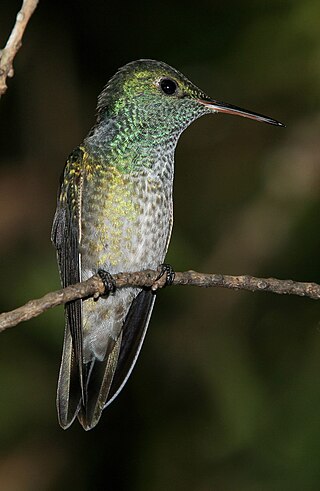
The versicoloured emerald is a species of hummingbird from central and eastern South America.
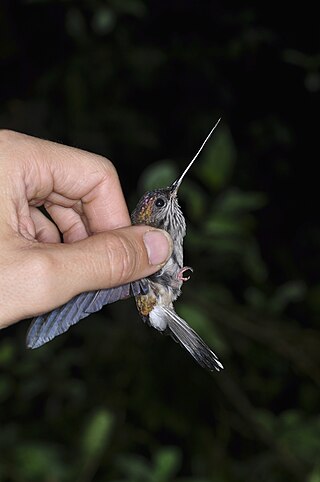
The tooth-billed hummingbird is a species of bird from the family Trochilidae. It is monotypic within the genus Androdon. It is found in humid forests in western Colombia, north-western Ecuador, and far eastern Panama. While generally scarce, localized and associated with the highly threatened humid sections of the Chocó, its range remains relatively large, and it is therefore considered to be of least concern by BirdLife International.

Chalcostigma is a genus of South American hummingbirds in the family Trochilidae.

Chlorostilbon is a genus of hummingbird in the family Trochilidae, known as emeralds. A single species, the blue-chinned sapphire is variously placed in the monotypic genus Chlorestes or in Chlorostilbon. The taxonomy of the C. mellisugus superspecies is highly complex and, depending on view, includes 1-8 species. All species in this genus have straight black or black-and-red bills. The males are overall iridescent green, golden-green or bluish-green, and in some species the tail and/or throat is blue. The females have whitish-grey underparts, tail-corners and post-ocular streak.

The caribs are a genus, Eulampis, of hummingbirds in the family Trochilidae. The genus contains two species, both of which are endemic to the islands of the Caribbean. The genus name comes from the Ancient Greek word eulampēs meaning 'bright shining'.

The swallow-tailed hummingbird is a species in the hummingbird family (Trochilidae), found mainly in east-central South America. Most authorities place it in the genus Eupetomena, although some place it in Campylopterus based on song and the thick shafts of the males' first primaries. Its common name and specific epithet both refer to the long, deeply forked, somewhat swallow-like tail.

The hillstars are hummingbirds of the genus Oreotrochilus. They are native to the Andes in South America.
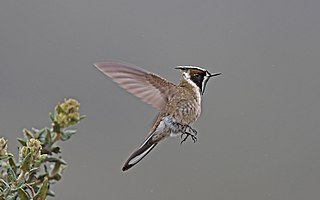
The bearded helmetcrests (Oxypogon) are a genus of hummingbird in the family Trochilidae. They are found in Colombia and Venezuela. Primary natural habitat is subtropical or tropical high-altitude grassland, known as páramo. The genus contains four species.
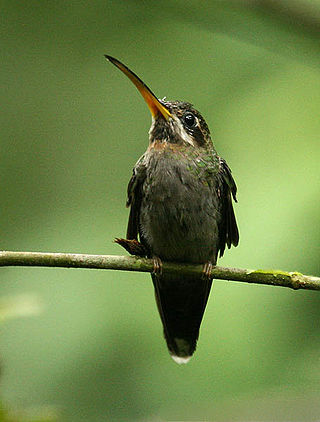
The barbthroats are a genus Threnetes of South American hummingbirds in the family Trochilidae.

The topazes are two species of hummingbirds in the genus Topaza. They are found in humid forests in the Amazon Basin. Males are by far the largest hummingbirds in their range – the giant hummingbird of the Andes is the only larger species in the family. Males have a total length of about 22 cm, although this includes their elongated rectrices. They are colourful, being mainly strongly iridescent golden and crimson with a black hood and a green throat. Females lack the elongated rectrices and have a mainly green plumage.

The streamertails are hummingbirds in the genus Trochilus, that are endemic to Jamaica. It is the type genus of the family Trochilidae. Today most authorities consider the two taxa in this genus as separate species, but some continue to treat them as conspecific, in which case scitulus is a subspecies of T. polytmus. A wide range of common names apply to this combined species, including green-and-black streamertail, Jamaican streamertail or simply streamertail. The name streamertail is a reference to the greatly elongated rectrices of the males.

Saucerottia is a genus of birds in the family Trochilidae, or hummingbirds.
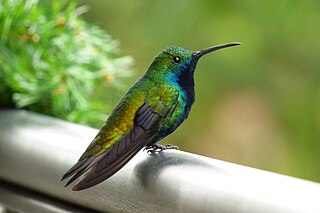
Polytminae is one of the six subfamilies of the hummingbird family Trochilidae. The subfamily contains 12 genera with a total of 29 species.

Heliantheini is one of the two tribes that make up the subfamily Lesbiinae of the hummingbird family Trochilidae. The other tribe in the subfamily is Lesbiini.

Lesbiini is one of the two tribes that make up the subfamily Lesbiinae in the hummingbird family Trochilidae. The other tribe is Heliantheini (brilliants).

Lampornithini is one of the three tribes that make up the subfamily Trochilinae in the hummingbird family Trochilidae. The other two tribes in the subfamily are Mellisugini (bees) and Trochilini (emeralds).
